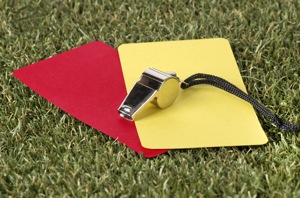What Do Yellow and Red Cards Mean in Football?

There aren’t many football games that don’t feature at least one player receiving a red or yellow card at some point during the match. Issued by the referee to punish and warn against fouls and misconduct many people assume they have always been a feature of the game.
However, they are actually a much more recent phenomenon and to understand what they mean, it’s useful to know why they were brought in.
The Origins of Red and Yellow Cards
Red and yellow cards were invented in 1966 by Ken Aston who was responsible for overseeing the referees at that year’s World Cup. With the variety of languages spoken in the World Cup, Aston saw several instances where it was not always clear to both players and spectators what decision the referee was making during the game. It was then he came up with the colour coded card system that we know today. His system was first used in the 1970 World Cup and is now used throughout football and in many other sports.
What Does a Yellow Card in Football Mean?
In football a yellow card is a caution. It is issued to a player who has committed misconduct or some other serious offence. There are a total of six offences that can lead to a yellow card, including:
Unsporting Behaviour
This is can be a broad number of actions or types of conduct that are not deemed as being sportsmanlike. Examples can include attempting to deceive the referee by ‘diving’ or celebrating a goal in an over elaborate or extravagant manner.
Dissent by Action or Word
The referee has to have complete authority on the field of play so anything that challenges this can be classed as dissent. Examples can include comments that are excessively loud at an official or several players congregating around an official disagreeing with a decision.
Continuous Infringement of Laws
It’s understandable that some form of infringement of the rules will occur during a football match. However, if a player is deemed to be doing it on a persistent basis, the referee will issue them with a yellow card.
Delaying Play Restarting
Also known as time wasting. This can include a player taking an excessive amount of time to take a free kick or even deliberately taking it from an incorrect position knowing the referee will order it to be taken again.
Not Standing the Required Distance
Opposing players must stand 10 yards away from the ball at a free kick or corner. Failure to so after being warned can result in a free yellow card.
Entering or Re-entering the Field
Once the game is in progress, players cannot enter or re-enter the field or deliberately leave the field of play without the express permission of the referee. Failure to do so is an automatic yellow card.
What Does a Red Card in Football Mean?
A red card in football means two things when shown to a player. Firstly, they have committed a serious foul or have committed serious misconduct in another way. Secondly, they will have to leave the field of play immediately. There are five main reasons for a red card to be shown, including:
Serious Foul Play
What constitutes serious foul play is somewhat subjective and is ultimately up to the judgement of the referee. Examples can include actions such as two-footed tackles and any other activity that can endanger the safety of another player.
Spitting and Abusive Language
Spitting is almost always a straight red card and abusive language is dealt with harshly too. This can include insults or remarks that could be deemed racist or offensive in another way.
Violence
Anything violent such as kicking, punching, elbowing, kneeing or attacking an opponent in any way will almost certainly be dealt with by the issuing of a red card.
Deliberately Fouling
When an attacker has a clear goal scoring opportunity and deliberately fouls to prevent the goal, it is an automatic red card. This is also the case for intentionally using hands or arms to block an attempt on goal.
Receiving Two Yellow Cards
In football, two yellow cards equal a red card. Thus if a player commits two fouls that are worthy of being a yellow card for each one, then a red will automatically be issued and the player will have to leave the field of play.